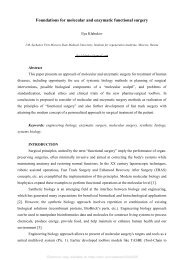Engineering Biology Problems Book (2021, Obninsk Edition)
You also want an ePaper? Increase the reach of your titles
YUMPU automatically turns print PDFs into web optimized ePapers that Google loves.
What if you could modify them to diagnose and treat diseases? Several companies are testing whether
engineered bacteria can treat conditions that affect the brain, liver and other organs, kill harmful
microbes and even cancers!
One of the problems of engineered microbiota is to prevent its spreading outside the human body.
SOLUTION:
The solution could be in using a toxin controlled by a low-temperature inducible promoter. As soon as
bacteria leave the human, they would be killed by the toxin
4.21. Fluorescent bacteria(by Dmitrii Vladimirtsev, MIPT_MSU team iGEM 2021)
For the experiment, you need to prepare bacteria with genes for fluorescent proteins. Bacteria with
RFP (red fluorescent protein) protein, which was expressed from the plasmid with the ampicillin
resistance gene jv, grew on a Petri dish.
We took a smear of bacteria and set them to grow in a liquid medium at 37 degrees and stirring (500
rpm). Arriving at the laboratory the next day, they found that the bacteria had grown, but they did not
fluoresce. Why?
SOLUTION:
There may be 2 reasons that overlap with each other. The main reason is that the antibiotic was not
added to the liquid medium. It follows from this that bacteria that did not carry the fluorescent protein
plasmid multiplied faster than those that did. The second reason is that due to the lack of need for
resistance to ampicillin, bacteria could simply "throw out" the plasmid.
4.22. Green light(by Dmitrii Vladimirtsev, MIPT_MSU team iGEM 2021)
It is necessary to make a plasmid with GFP for transfection of eukaryotic MCF7 cells. To produce a
plasmid, E. coli was transformed, but not a single colony glowed, even when excited with ultraviolet
light. However, upon transfection with MCF7, a green glow is observed in most of the cells. How can
this be explained?
SOLUTION:
It's all about the promoter, which is in front of the GFP in the plasmid. Since the ultimate goal was the
fluorescence of eukaryotic cultures, a strong eukaryotic promoter (for example, the CMV promoter)
was inserted into the plasmid. However, this promoter was extremely weak for E. coli, so no GFP
expression was observed in it.












